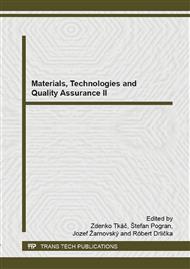p.67
p.75
p.83
p.91
p.99
p.105
p.111
p.119
p.127
Setting Marginal Limits of Stress of Quick-Setting Adhesives Based on Cyanoacrylates
Abstract:
The application of quick-setting adhesives based on cyanoacrylates is considerably spread in technical practice. The limit of these adhesives is the 'zero layer' of the adhesive. The advantage is in the speed of hardening process. A fast creation of bond, minimalizing of fixation means, and the possibility of fast manipulation with the adhesive bond are connected with that. The goal of the research is to describe the behaviour of quick-setting adhesives based on cyanoacrylates at different speed of deformation of adhesive bonds in the interval from 1 mm.min-1 to 48 mm.min-1. The change of adhesive bond strength, deformation and failure time were evaluated in experiments. A 3D model was set from experiment results by means of the least-square method.
Info:
Periodical:
Pages:
99-104
Citation:
Online since:
December 2014
Authors:
Keywords:
Price:
Сopyright:
© 2014 Trans Tech Publications Ltd. All Rights Reserved
Share:
Citation:


